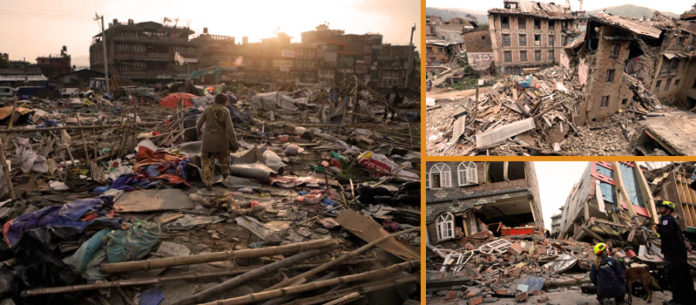Nepal has witnessed many earthquakes, last being in 2015, owing to its location in one of the most seismically active regions. As per the global reports, Nepal ranks 11th among earthquake-prone countries. The East Nepal Earthquake which occurred on 21st August 1988 claimed several lives after which various initiatives were made to strengthen the disaster management of the country. The effect of the earthquake extended to the border of Bihar also damaging the buildings of the Indian state, Raj Bhavan and the old Secretariat Building in Patna among them.
What we are going to explore in the following article
- Location of Nepal and its exposure to earthquakes
- Details of the 1988 disastrous Earthquake
- The recent Earthquake of 2015
- Why is the damage more than it should actually be?
- Steps taken to strengthen the Disaster Management
Location of Nepal and its exposure to earthquakes
Nepal is one of the most disaster-prone countries in the world, owing to its location in the centre of the Himalayan range. The topography and climate serve as the catalyst to the disasters hitting this country. The small mountainous country is located in a seismic region which is highly active, increasing its vulnerability to earthquakes.
- Nepal is crossed by the Himalayas from the west to the east.
- Most of the area of the country is located at the height of 3000 metres above sea level.
- The Himalayas which are in Nepal have been shaped by the collision of the Indian continental and the Eurasian continental plates.
- As per an article posted at eskp.de the Indian plate moves towards the Eurasian plate at a speed of approximately 4.5 cm every year.
- The mechanical stress caused due to the tectonic plate movements on the landmass of Nepal causes earthquakes in the region.
Apart from earthquakes other natural disasters which affect the fragile ecosystem of the mountainous country are landslides, forest fires, floods and thunderbolts. These disasters have not only caused damage to life and property but have also disrupted the economic development of this nation.
There have been two major earthquakes in the twentieth century, the one in 1988 and the one in 2015.
Details of the 1988 Disastrous Earthquake
- The earthquake hit the Bihar bordered Nepal region on 21st August 1988.
- The magnitude of the earthquake on the Richter scale was 6.9.
- The landmass was hit by the earthquake in two instalments of 10 seconds and 15 seconds each.
- The deaths recorded in the affected region was 709 and thousands of people were injured.
- Buildings were damaged and the damage extended to Bihar also. Raj Bhavan and the Old Secretariat in Patna were among the damaged structures in Bihar.
Details of the 2015 Earthquake
- The earthquake hit the landmass on 25th April 2015.
- The magnitude of the earthquake was 7.8. This earthquake and its aftershocks are believed to cause maximum damage in the history of earthquakes in Nepal.
- The disaster took approximately 9000 lives and injured about 23,000 people.
- About 8,80,000 houses were damaged.
Why is the damage more than it should actually be?
There are various factors which serve as a catalyst to the destruction caused by the earthquakes in Nepal.
- Increase in population growth: An rapid population growth and the activities which follow have put an additional burden on an already sensitive landmass. The casualties are higher in case of a densely populated area which is so prone to a natural disaster.
- Poor construction practices: The use of poor construction materials, lack of proper construction practices, a poor population has increased the risk of damage to a greater magnitude.
- Uncontrolled development: The increase in population, the majority of which is poor has led to the development in an unplanned and uncontrolled manner.
- Lack of knowledge: It is important to eradicate the ignorance regarding the life hacks to escape earthquakes caused the disaster.
- Inadequate disaster management.
Steps taken to strengthen the Disaster Management
To prevent the loss of human life and property several initiatives have been taken by the government which has also received aid from international organizations.
- Activities to raise awareness: 15th January (1934 earthquake day) has been declared as the Earthquake Safety Day by the Government of Nepal. Several activities are organised to raise public awareness regarding seismic activities and measures to escape the disaster. Earthquake Parade, table shaking demonstrations, dedicated radio and television programmes are some of the activities organised in order to engage people and increase awareness among them.
- Kathmandu Valley Earthquake Risk Management Project: This project which derives most of its funds from the Office of Foreign Disaster Assistance of USAID focuses on earthquake preparedness. It is a collaboration of the Nepal Government, municipal corporations in the Kathmandu Valley, professional societies, academic institutions and international agencies present there.
- School Earthquake Safety Programme: School being the epicentre of knowledge for the new generation was focused. The buildings were strengthened so that the damage is less when an earthquake hits the landmass. Apart from the building strengthening, the programme extended to the training sessions for students and teachers for disaster preparedness.
- Safety for Hospitals: Earlier the earthquakes in Nepal used to render the hospitals inoperable. The Nepal Government focused on the development of the hospitals so that in times of a disaster, the hospitals could give services efficiently.
Wrapping Up
Earthquakes are one of the ways in which nature expresses its fury. Most of the time humans trigger these disasters by their activities. Initiatives should be made by the Government at grassroot levels to prepare the vulnerable areas so that damage can be minimised. Nepal’s growing seismic requires a clear implementation of policies and investment to support these policies. International organizations have shown support for these initiatives so that precious lives can be saved.











































